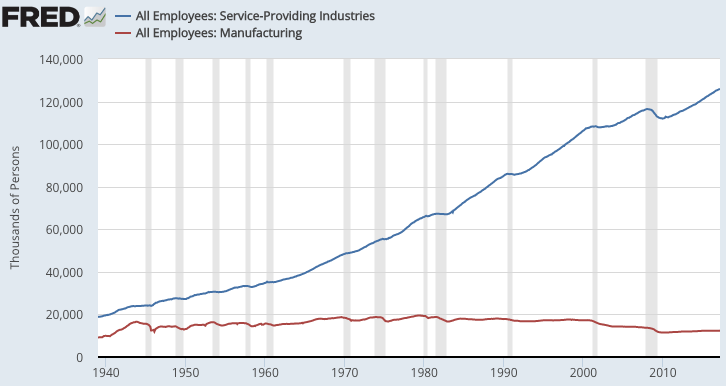I spend a lot of time thinking and writing about how better technology and an improved knowledge base are affecting the financial markets but these changes will likely have an even greater impact on the labor markets. I tell my wife all the time that our three-year-old will probably work in a job or industry that doesn’t currently exist.
Just this week Facebook announced they’re hiring 3,000 people to monitor videos on their site for violence or criminal activities. This is the bizarre world we live in now but my guess is that technology will continue to force changes in the way people work going forward if even half of the predictions coming out of the Silicon Valley crowd come true.
The biggest change from previous generations, and one that’s already been in place for a while now, is that we’ll see a continued shift from manufacturing to service-oriented jobs. You can clearly see where things have been heading:

As we move from a product-centric world to a service-centric one, people and firms are going to have to master new skills to survive.
The biggest problem for people in the services industry is that it’s not a tangible good like a product. There’s much more faith involved in the process. You can’t always tell the difference between luck and skill in service-related businesses and quality is often in the eye of the beholder.
Harry Beckwith talks about these ideas in his very useful book, Selling the Invisible: A Field Guide to Modern Marketing:
America is a service economy with a product marketing model. But services are not products, and service marketing is not product marketing.
A product is tangible. You can see it and touch it. A service, by contrast, is intangible. In fact, a service does not even exist when you buy one. If you go so a salon, you cannot see, touch, or try out a haircut before you buy it. You order it. Then you get it.
You usually know when a product fails. The stereo stops playing, the clutch stops clutching, the milk tastes terrible. Knowing when a service fails is much harder. Was that good advice from your benefits consultant, or good painting from your house-painter – that is, was it the service you bargained for? Who knows?
Because most product failures are obvious and provable, most products can be warranted. Most services cannot be. As a result, your only recourse for most service failures is either painful negotiation or agonizing litigation.
So you buy a service with no guarantees – and even more uncertainty.
Beckwith lays out what this means for those working in a service capacity. Here are some of my thoughts about what people can do in a more service-oriented workforce to help them stand out from the crowd:
Understand people and build relationships. Since you’re selling something that’s invisible to the client at the outset, you have to be a good relationship builder to succeed in the service industry. You’re selling a service but you’re also selling yourself, your vision, your philosophy, and values. You have to make people feel comfortable. Being likable is a prerequisite when the customer has endless choices at their fingertips. Beckwith says, “Prospects do not buy how good you are at what you do. They buy how good you are at who you are.”
Try to stand out. Everyone assumes they’re a special snowflake but in reality, many people, firms, and services in the same industry have fairly similar offerings. Beckwith says, “The more similar the services, the more important the differences. Accentuate the trivial.”
Learn how to tell a good story. Humans are narrative-seeking creatures. Storytelling ability is what helped us go from small tribes to enormous cities, cultures, and organizations. Most sales pitches are boring and full of cliches. I find that metaphors almost always work better than technical details. Those who can tell their story in an engaging way will have a leg up on the competition. Everyone is in sales.
Simplify. This is especially true in the finance world where it’s nearly impossible for people outside of the industry to figure out what it is we all do. The world is a complex place and the last thing people need is more complexity when trying to make difficult decisions. When selling something complex you have to bring things down to the lowest common denominator. Simple beats complex in a world overflowing with choice.
Figure out how to correctly track progress. Selling intangibles becomes even more difficult when building a long-term relationship with a client because it’s hard to see results over the short-term. This is why so many investors focus on short-term performance — it’s tangible. The way to get beyond the meaningless short-term performance dance is to focus on process. You tell the customers what you’ll do for them and then go out and do exactly what you said. It’s also more important than ever to be as transparent as possible with everything you’ll be doing for your clients. Much of the work in service industries is never seen by the client so it pays to open up the curtain and let them know everything they’re getting.
Develop your brand. I cringed a little bit when I wrote this because this is what everyone says these days but it’s true. But a brand isn’t necessarily what most people assume. It’s not a symbol or an ad or a tagline. A good brand is associated with a trustworthy firm that will perform like it’s supposed to perform. Service businesses are built on promises. A good brand is synonymous with a firm or person who will fulfill those promises on a consistent basis so you know exactly what you’re getting when you sign up.
Source:
Selling the Invisible: A Field Guide to Modern Marketing
Further Reading:
Everyone is in Sales
